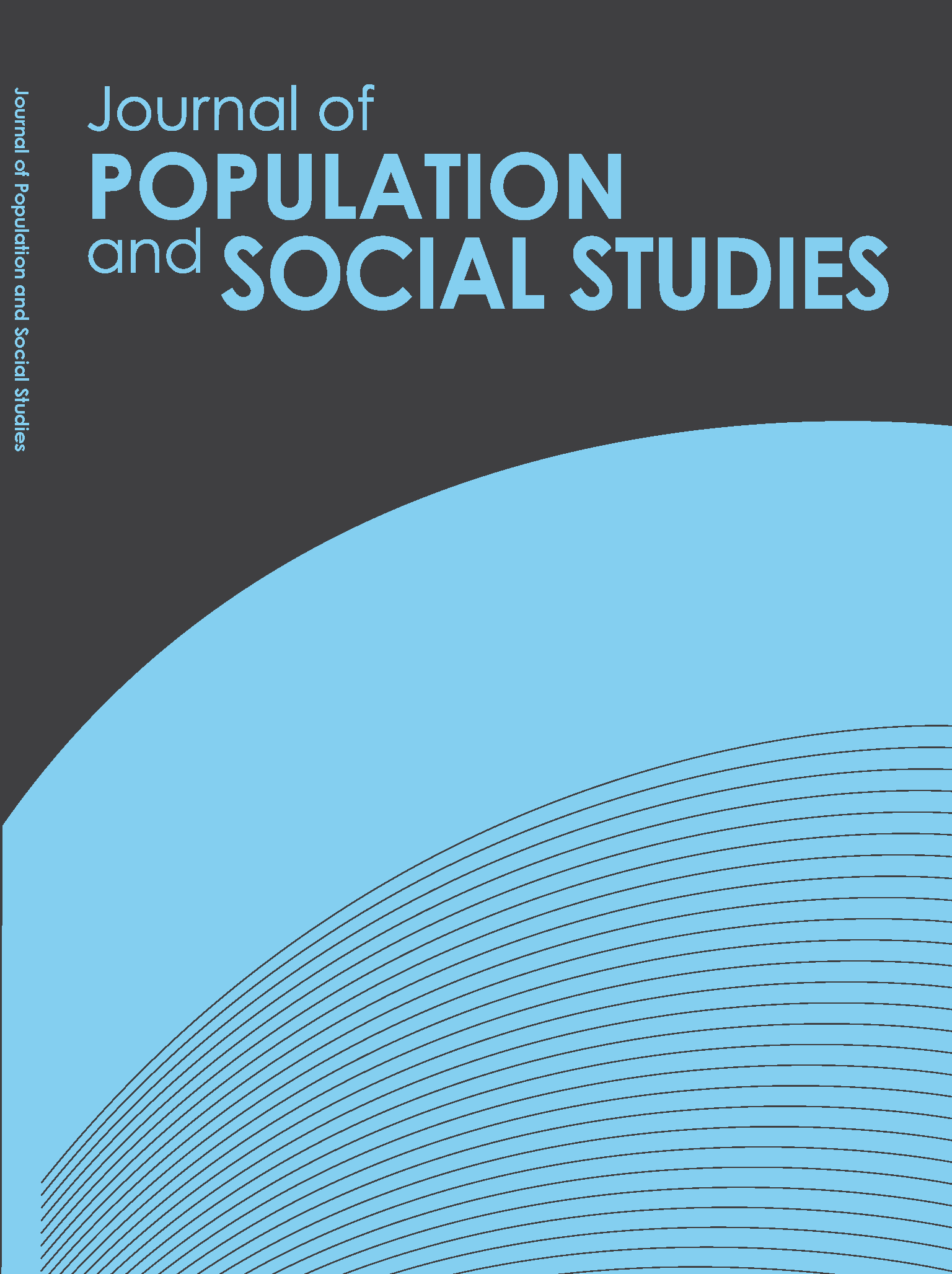Knowledge and Practice of Menstrual Regulation (MR) in Bangladesh: Patterns and Determinants
Main Article Content
Abstract
Menstrual regulation (MR) is often used as a substitute for abortion in Bangladesh. This study attempts to assess the patterns and determinants of the knowledge and practice of MR in that country. Data from the nationally representative cross-sectional Bangladesh Demographic and Health Survey 2001-2014 were employed and both bivariate and multivariable analyses were used. The findings show that both the knowledge and practice of MR is decreasing in Bangladesh. The knowledge of MR was about 82% in 2004, but it dropped to 45% in 2014. The prevalence of MR was 6.4% in 2011, but it decreased to 5.5% in 2014. The incidence of MR was 2.1% in 2011, which fell to 1.4% in 2014. Age, region, place of residence, wealth index, access to media, and use of contraception appeared to be significant determinants of MR. In order to reduce the frequency of MR being used as a form of contraception, this study highlights the necessity to emphasize the delivery of family planning services in Bangladesh to ensure the utilization of alternative modes of contraception.
Article Details
References
• Ahmed, B.M.K., Rahman, M., & Ginneken, J. Van. (1998). Induced abortion in Matlab, Bangladesh: Trends and determinants. International Family Planning Perspectives, 24(3), 128–132. Retrieved from http://0-www.jstor.org.wizard.umd.umich.edu:80/stable/pdfplus/3038209.pdf
• Ainul, S., Bajrachrya, A., & Reichenbach, L. (2017). Adolescents in Bangladesh: A situation analysis of programmatic approaches to sexual and reproductive health education and services. Population Council, The Evidence Project. Retrieved from http://evidenceproject.popcouncil.org/wp-content/uploads/2017/02/Bangladesh-ASRH-Report_January-2017.pdf
• Chowdhury, S.N.M., & Moni, D. (2004). A situation analysis of the menstrual regulation programme in Bangladesh. Reproductive Health Matters, 12(24 SUPPL.), 95–104. doi: https://doi.org/10.1016/S0968-8080(04)24020-4
• Clegg, L.X., Hankey, B.F., Tiwari, R., Feuer, E.J., & Edwards, B.K. (2009). Estimating average annual per cent change in trend analysis. Statistics in Medicine. doi: https://doi.org/10.1002/sim.3733
• DaVanzo, J., & Rahman, M. (2014). Pregnancy termination in matlab, Bangladesh: Trends and correlates of use of safer and less-safe methods. International Perspectives on Sexual and Reproductive Health. doi: https://doi.org/10.1363/4011914
• Elul, B. (2011). Determinants of induced abortion: An analysis of individual, household and contextual factors in Rajasthan, India. Journal of Biosocial Science. doi: https://doi.org/10.1017/S0021932010000490
• Hena, I.A., Rob, U., Sultana, N., Hossain, M.I., Yasmin, R., Das, T.R., & Ahmed, F.U. (2013). Introducing medical MR in Bangladesh MRM. Population Council, 28. Retrieved from https://www.popcouncil.org/uploads/pdfs/2013RH_STEPUPMRMBangladesh.pdf
• Hossain, A., Maddow-Zimet, I., Ingerick, M., Bhuiyan, H.U., Vlassoff, M., & Singh, S. (2017). Access to and quality of menstrual regulation and postabortion care in Bangladesh: Evidence from a survey of health facilities, 2014. Retrieved from https://www.guttmacher.org/sites/default/files/report_pdf/menstrual-regulation-postabortion-care-bangladesh_0.pdf
• Huda, A., Sarker, K., Azmi, A.J., & Reichenbach, L. (2013). Understanding unintended pregnancy in Bangladesh: Country profile report. STEP UP Research Report. doi: https://doi.org/10.1177/0022034510376046
• Islam, M.M., Rob, U., & Chakroborty, N. (2004). Menstrual regulation practices in Bangladesh: An unrecognized form of contraception. Asia-Pacific Population Journal. Retrieved from https://www.researchgate.net/publication/237051031_Menstrual_Regulation_Practices
_in_Bangladesh_An_Unrecognized_Form_of_Contraception
• Kapil Ahmed, M., van Ginneken, J., & Razzaque, A. (2005). Factors associated with adolescent abortion in a rural area of Bangladesh. Tropical Medicine & International Health: TM & IH, 10(2), 198–205. doi: https://doi.org/10.1111/j.1365-3156.2004.01362.x
• Ministry of Health and Family Welfare (2014). পরিবার পরিকল্পনা অধিদপ্তর-স্বাস্থ্য ও পরিবার কল্যাণ মন্ত্রণালয়. [History | Directorate general of family planning, Ministry of health and family welfare]. Retrieved October 6, 2016, from http://www.dgfp.gov.bd/site/page/ca81e7a3-33dd-442b-90bc-da21a34a0c13/History
• Nashid, T., & Olsson, P. (2007). Perceptions of women about menstrual regulation services: Qualitative interviews from selected urban areas of Dhaka. Journal of Health, Population, and Nutrition, 25(4), 392–398. Retrieved from http://www.ncbi.nlm.nih.gov/pubmed/18402181
• National Institute of Population Research and Training (NIPORT), Mitra and Associates, & ICF International (2013). Bangladesh Demographic and Health Survey 2011. Retrieved from http://dhsprogram.com/publications/publication-FR265-DHS-Final-Reports.cfm
• National Institute of Population Research and Training (NIPORT), Mitra and Associates, & ICF International (2016). Bangladesh Demographic and Health Survey 2014. Retrieved from http://dhsprogram.com/publications/publication-FR311-DHS-Final-Reports.cfm
• National Institute of Population Research and Training (NIPORT), Mitra and Associates, & Macro International (2009). Bangladesh Demographic and Health Survey 2007. Retrieved from http://dhsprogram.com/publications/publication-FR207-DHS-Final-Reports.cfm
• National Institute of Population Research and Training (NIPORT), Mitra and Associates, & ORC Macro (2005). Bangladesh Demographic and Health Survey 2004. Retrieved from http://dhsprogram.com/publications/publication-FR165-DHS-Final-Reports.cfm
• Planning Commission (1973). The first five-year plan, 1973-1978, 549.
• Singh, S., Hossain, A., Maddow-Zimet, I., Bhuiyan, H.U., Vlassoff, M., & Hussain, R. (2012). The incidence of menstrual regulation procedures and abortion in Bangladesh, 2010. International Perspectives on Sexual and Reproductive Health, 38(3), 122–132. doi: https://doi.org/10.1363/3812212
• Uddin, M.N. (2012). Knowledge and practice of menstrual regulation: an assessment among the underprivileged people in Bangladesh. Antrocom Online Journal of Anthropology, 8(2).
• Vlassoff, M., Hossain, A., Maddow-Zimet, I., Singh, S., & Bhuiyan, H.E. (2012). Menstrual regulation and postabortion care in Bangladesh: Factors associated with access to and quality of services. Guttmacher Institute. Retrieved from https://pdfs.semanticscholar.org/240a/d34741ae2c70e8619247e1395538a0196f62.pdf


